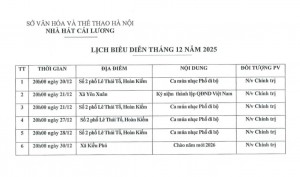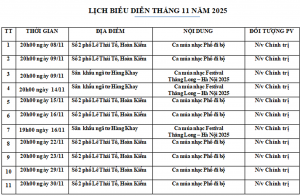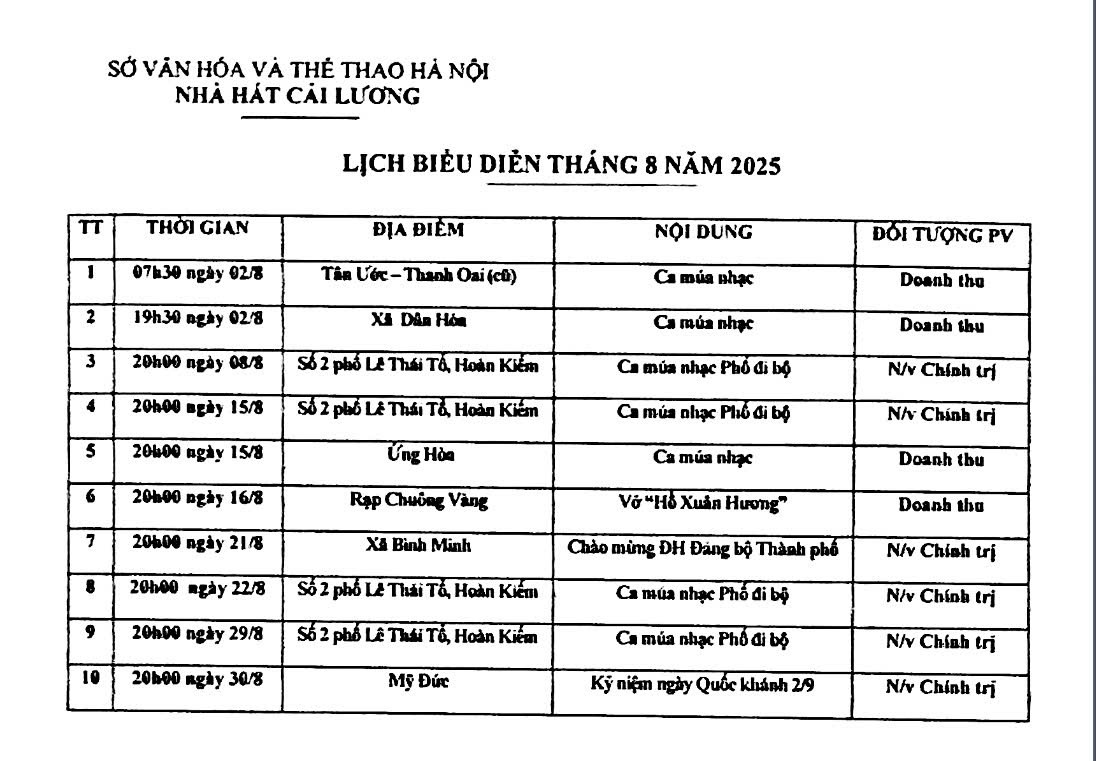Bài viết trong » 2025 «
Sáng ngày 15/12/2025 tại rạp Chuông Vàng, số 72 Hàng Bạc, Hoàn Kiếm, Công đoàn Nhà hát Cải lương Hà Nội đã tổ chức Đại hội nhiệm kỳ 2025 – 2023.
Tới dự có các đồng chí lãnh đạo đơn vị cùng toàn thể công đoàn viên Nhà hát.
Sau buổi sáng làm việc tập trung, hiệu quả, đại hội đã tổ chức hoàn thành tốt các nội dung đã đề ra theo kế hoạch.
Một số hình ảnh:


Thực hiện thông báo số 966/TB-SVHTT ngày 05/11/2025 của Sở Văn hóa và Thể thao Hà Nội về việc phân công nhiệm vụ biểu diễn nghệ thuật tại “Festival Thăng Long – Hà Nội năm 2025”, Nhà hát Cải lương Hà Nội đã tổ chức biểu diễn nghệ thuật phục vụ chuỗi hoạt động vào tối ngày 09;14;16/11/2025 tại sân khấu ngoài trời phố Hàng Khay.
Một số hình ảnh:






Căn cứ Kế hoạch hoạt động năm 2025, Nhà hát Cải lương Hà Nội thông báo lịch tổ chức LỄ GIỖ TỔ NGÀNH SÂN KHẤU NĂM 2025, cụ thể như sau:
I. THỜI GIAN , ĐỊA ĐIỂM
* Thời gian: 18h00’ ngày 02/10/2025 (tức ngày 11 tháng 8 Âm lịch).
* Địa điểm: Rạp Chuông Vàng, 72 phố Hàng Bạc, Hà Nội.
II. NỘI DUNG
- 17h30: Đón tiếp đại biểu;
-18h00: Tuyên bố lý do giới thiệu đại biểu;
- Chương trình Văn nghệ;
- Khai trống, dâng hương;
- Lãnh đạo Nhà hát phát biểu;
- Đại diện lãnh đạo Sở; nghệ sĩ lão thành phát biểu;
- Thụ lộc Tổ.
Kính mời Quý vị đại biểu, cán bộ lão thành và lãnh đạo, cán bộ, diễn viên, CNV Nhà hát tới dự để buổi Lễ được tổ chức thành công tốt đẹp.
Trân trọng./.
Được sự đồng ý của Sở Văn hóa và Thể thao Hà Nội, Sáng ngày 05/9/2025, tại rạp Chuông Vàng, số 72 Hàng Bạc, Hoàn Kiếm, Nhà hát Cải lương Hà Nội tổ chức Lễ Khởi công tác phẩm: Vua Hoá Hổ
Đến dự và chỉ đạo có: Nhạc sỹ Phạm Chỉnh – Giám đốc Nhà hát.
Đến dự còn có các đồng chí trong Ban Giám đốc; Cán bộ chủ chốt các Phòng – Đoàn, các thành viên ekip sáng tạo và cán bộ, nghệ sỹ, công nhân viên Nhà hát.
Nhạc sỹ Phạm Chỉnh – Giám đốc Nhà hát cho biết: “Năm 2025 với nhiều ngày lễ lớn, sự kiện lịch sử quan trọng, các nhiệm vụ chuyên môn thường xuyên và đột xuất, toàn thể cán bộ, nghệ sỹ, công nhân viên nhà hát đã đoàn kết, nỗ lực vượt qua khó khăn để hoàn thành xuất sắc các nhiệm vụ được giao. Nhạc sỹ Phạm Chỉnh – Giám đốc Nhà hát đề nghị đơn vị tiếp tục cố gắng, tập trung để luyện tập và tổ chức tổng duyệt theo tiến độ kế hoạch đã được Sở Văn hóa và Thể thao Hà Nội phê duyệt”.
Một số hình ảnh lãnh đạo :



Thực hiện Kế hoạch số 354/KH-SVHTT ngày 24/6/2025 của Sở Văn hóa và Thể thao Hà Nội về việc tổ chức hoạt động biểu diễn nghệ thuật chào mừng kỷ niệm 80 năm Cách mạng tháng Tám thành công (19/8/1945 – 19/8/2025) và Quốc khánh nước Cộng hòa xã hội chủ nghĩa Việt Nam (02/9/1945 – 02/9/2025)
Nhà hát Cải lương Hà Nội đã phối hợp các đơn vị địa phương tổ chức biểu diễn các chương trình nghệ thuật phục vụ nhân dân vào tối 30/8 tại xã Mỹ Đức và tối 02/9 tại phường Tây Hồ.

* Tham dự chương trình có các đồng chí đại diện lãnh đạo xã Mỹ Đức và phường Tây Hồ. cùng đông đảo khán giả đến xem và cổ vũ chương trình.
* Nhạc sỹ Phạm Chỉnh – Giám đốc Nhà hát Cải lương Hà Nội dự và chỉ đạo trực tiếp các chương trình.





* Với chủ đề ca ngợi Đảng Cộng sản Việt Nam quang vinh, ca ngợi Chủ tịch Hồ Chí Minh vĩ đại, ca ngợi lịch sử hào hùng dân tộc Việt Nam và chào mừng kỷ niệm 80 năm Cách mạng tháng Tám thành công (19/8/1945 – 19/8/2025) và Quốc khánh nước Cộng hòa xã hội chủ nghĩa Việt Nam (02/9/1945 – 02/9/2025), ca ngợi tình yêu quê hương đất nước. Chương trình được dàn dựng công phu, nhiều hình thức biểu diễn phong phú với các tiết mục đặc sắc…..qua phần biểu diễn của các nghệ sĩ, diễn viên: NSND Thanh Hương, NSND Đào Trung, NSUT Hoàng Viện, NSUT Hồng Nhung, NSUT Thái Vân, NSUT Quang Thanh, NSUT Quang Tuấn, NS Minh Đức, NS Thiên Hương và các nghệ sĩ tài năng: NS Thu Hường, NS Nhật Linh, NS Ngân Hiền, NS Minh Thêm …cùng dàn nhạc và nhóm múa Nhà hát Cải lương Hà Nội ….Chương trình nghệ thuật đã để lại ấn tượng sâu sắc trong lòng khán giả.
Chỉ đạo nghệ thuật: Nhạc sỹ Phạm Chỉnh – Giám đốc Nhà hát Cải lương Hà Nội


Thực hiện Thông báo số 414/TB-SVHTT ngày 23/6/2025 của Sở Văn hóa và Thể thao Hà Nội về việc phân công nhiệm vụ biểu diễn nghệ thuật kỷ niệm 78 năm Ngày Thương binh – Liệt Sỹ (27/7/1947 – 27/7/2025). Nhà hát Cải lương Hà Nội tổ chức biểu diễn chương trình nghệ thuật phục vụ nhân dân tại sân khấu ngoài trời phường Sơn Tây

* Tham dự chương trình có các đồng chí đại diện lãnh đạo phường Sơn Tây, cùng đông đảo khán giả đến xem và cổ vũ chương trình.
* Nhạc sỹ Phạm Chỉnh – Giám đốc Nhà hát Cải lương Hà Nội dự và chỉ đạo trực tiếp chương trình.


* Với chủ đề ca ngợi Đảng Cộng sản Việt Nam quang vinh, ca ngợi Chủ tịch Hồ Chí Minh vĩ đại, ca ngợi lịch sử hào hùng dân tộc Việt Nam và kỷ niệm 78 năm Ngày Thương binh – Liệt Sỹ (27/7/1947 – 27/7/2025), ca ngợi tình yêu quê hương đất nước. Chương trình được dàn dựng công phu, nhiều hình thức biểu diễn phong phú với các tiết mục đặc…..qua phần biểu diễn của các nghệ sĩ, diễn viên: NSND Thanh Hương, NSND Đào Trung, NSUT Hoàng Viện, NSUT Hồng Nhung, NSUT Quang Thanh, NSUT Quang Tuấn, NS Minh Đức, NS Thiên Hương và các nghệ sĩ tài năng: NS Thu Hường, NS Nhật Linh, NS Ngân Hiền, NS Minh Thêm …cùng dàn nhạc và nhóm múa Nhà hát Cải lương Hà Nội ….Chương trình nghệ thuật đã để lại ấn tượng sâu sắc trong lòng khán giả.




Chỉ đạo nghệ thuật: Nhạc sỹ Phạm Chỉnh – Giám đốc Nhà hát Cải lương Hà Nội

Được sự đồng ý của Sở Văn hóa và Thể thao Hà Nội, tối ngày 30/6/2025, tại rạp Chuông Vàng, số 72 Hàng Bạc, Hoàn Kiếm, Nhà hát Cải lương Hà Nội tổ chức tổng duyệt vở “Kỹ nữ thành Đông Quan.
DANH SÁCH CỘNG TÁC VIÊN
Tác giả kịch bản : Cố Tác giả Kiến Quốc
Chuyển thể Cải lương : Cố NSUT Xuân Hỷ
Đạo diễn phục dựng : NSUT Hoàng Viện
Bổ sung bài ca : NSUT Nhật Minh – NSUT Hoàng Viện
Âm Nhạc : NSND Đào Trung
Thiết kế mỹ thuật : Vương Hải
Biên đạo múa : NS Lê Phương
Thực hiện phục trang : NSƯT Minh Hùng
Hướng dẫn Ca hát : NSND Thanh Hương
Trợ lý đạo diễn : NSUT Hồng Nhung
Thư ký đạo diễn : NS Thu Hường
Tổng đài : NS Xuân Hùng
Chỉ đạo Nghệ thuật : Giám đốc nhà hát – Nhạc sĩ Phạm Chỉnh


DANH SÁCH PHÂN VAI
1. Đào Nga NSND Thanh Hương NSUT Hồng Nhung
2. Trần Quân NSUT Quang Tuấn NSUT Hoàng Viện
3. Vương Thông
(Tướng nhà Minh) NS Quang Huy
4. Dũng Kỳ
(Cấp dưới của Vương Thông) NS Quang Thiếu
5. Lý Ngũ
(Cấp dưới của Dũng Kỳ) NS Xuân Hùng
6. Ông già ( bố Trần Quân) NS Đức Long
7. Bà già ( Mẹ Trần Quân) NS Đan Thanh
8. Nhật Thanh (con Trần Quân) NS Thu Hường
9. Cậu Ấm NS Tiến Hiệp
10. Lão Trương NS Quang Hưng
11. Bà Trương NSUT Kim Dung
12. Chủ quán NS Vân Anh Song Hà
13. Lính say
Lính Béo Trọng Vinh
Hoàng Dân
14. Mơ, Mận, Đào, Liễu Thêm, Liệu,
Hiền,T.Hà
Múa, Lính và các vai dân làng: Nhân, Thuyết, Tiến, Tuyến,
L.Hương, Hường, Quỳnh, S.Hà, D.Linh
Dàn nhạc cổ: - NS Như Sơn – Guitar phím lõm
- NSND Đào Trung – Vilon
- NS Đào Khiêm – Guitar Bass
- NS My Trang – Đàn Tam thập lục
- NS Trà My – Đàn Tranh
Chỉ huy dàn nhạc: NSND Đào Trung






